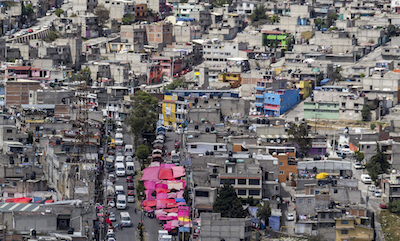As Latin American Populations Urbanize, Neighborhood Impacts Mental Health.
 Latin America has undergone rapid urbanization in recent years, with large numbers of internal migrants moving from rural areas to cities in search of education and employment. Demographic characteristics of neighborhoods in these cities are changing, and many neighborhoods are now seeing overcrowding, inequality, and higher levels of stress.
Latin America has undergone rapid urbanization in recent years, with large numbers of internal migrants moving from rural areas to cities in search of education and employment. Demographic characteristics of neighborhoods in these cities are changing, and many neighborhoods are now seeing overcrowding, inequality, and higher levels of stress.
Now, a new study led by School of Public Health researchers shows that both neighborhoods with lower-than-average and higher-than-average proportions of migrants have lower odds of mood and anxiety disorders among residents, as do neighborhoods with more education and less unemployment.
The study, published in Social Psychiatry and Psychiatric Epidemiology, found individuals living in neighborhoods with a lower proportion of migrants were 25 percent less likely to meet criteria for mood and anxiety disorders, regardless of their own migrant status, but that individuals living in neighborhoods with a higher-than-average proportion of migrants had similarly low odds of experiencing these disorders.
The finding in migrant-dense neighborhoods “could potentially be attributed to social support among migrants from common areas settling in certain neighborhoods and the creation of migrant enclaves,” says lead study author Laura Sampson, a statistical analyst and doctoral student in the Department of Epidemiology. “This type of support could have a buffering effect against increased stress due to overcrowding and rapid urbanization.”
The researchers used World Mental Health Survey data from 83 neighborhoods across five major cities in Latin America: Buenos Aires, Argentina; Medellín, Colombia; São Paulo, Brazil; Lima, Peru; and Mexico City, Mexico.
The survey assessed “internalizing disorders,” which include posttraumatic stress disorder, generalized anxiety disorder, and major depressive disorder, and other mood and anxiety disorders. It also assessed “externalizing disorders,” including intermittent explosive disorder and alcohol and drug abuse with or without dependence.
The researchers defined migrants as current city residents who were not raised in a large city. They also looked at individual demographics including age, sex, marital status, employment status, relative individual income, and educational attainment.
While the researchers did find that these individual-level factors were associated with the odds of someone meeting the criteria of an internalizing disorder, they also found strong associations with neighborhood-level demographics, independently of the individual demographics.
For each city, the researchers divided neighborhoods into three equally-sized groups for each neighborhood-level factor, representing the neighborhoods with the highest prevalence of the factor, the neighborhoods with the lowest prevalence, and the neighborhoods in between.
Individuals living in neighborhoods with lower proportions of migrants were 25 percent less likely to meet the criteria of an internalizing disorder than individuals living in neighborhoods closer to average, while individuals living in neighborhoods with higher proportions of migrants were 21 percent less likely.
Living in neighborhoods with a higher proportion of unemployed individuals was associated with a 49-percent increase in the odds of an internalizing disorder. Individuals in neighborhoods with higher proportions of more educated residents were 42 percent less likely to have an internalizing disorder, while those in neighborhoods with lower proportions of more educated residents were 24 percent less likely. For externalizing disorders, the only strong neighborhood-level association was with education: individuals in neighborhoods with higher proportions of more educated residents were 46 less likely to have an externalizing disorder.
While social support may be behind the observation of better mental health among people living in neighborhoods with the highest concentration of migrants, Sampson says, the findings could also be an extension of the “healthy migrant effect,” where healthier people are more likely to have the ability to leave their home communities. Further research will need to pick apart this and other relationships between mental health and neighborhood factors in Latin America, she says.
The study was co-authored by Shui Yu, a statistical analyst in the Department of Epidemiology, and Sandro Galea, Dean and Robert A. Knox Professor.
The other co-authors were: Silvia Martins of the Columbia University Mailman School of Public Health; Alexandre Dias Porto Chiavegatto Filho and Laura Helena Andrade of the University of São Paulo; Maria Carmen Viana of the Federal University of Espirito Santo in Vitória, Brazil; Maria Elena Medina-Mora of the National Institute of Psychiatry Ramon de la Fuente Muñiz in Mexico City; Yolanda Torres of the CES University in Medellín; Marina Piazza of Cayetano Heredia University in Lima and the National Institute of Health of Peru; Sergio Aguilar-Gaxiola of the University of California Davis School of Medicine; Alfredo H. Cia of the Anxiety Disorders Clinic and Research Center in Buenos Aires; Juan Carlos Stagnaro of the University of Buenos Aires; and Alan Zaslavsky and Ronald Kessler of Harvard University Medical School.